When you think of meditation you probably envision someone sitting up with legs crossed. But with Yoga Nidra you are actually lying down.
Can I Meditate Lying Down?
This seems to be a controversial question. Which find this pretty weird because meditating lying down helped me start my mediation practice.
And, Yoga Nidra is a form of meditation done lying down and is proven to calm the brain.
So yes, clearly you can meditate lying down!
Lying Down to Start Meditation
When I first started meditating, early on with my burnout, it was really hard. Meditating for even a few minutes was a challenge to be honest.
On some days the only way I could even try to meditate was lying down.

I remember one day where I was curled up sideways on the couch, trying to meditate with Jeff Warren’s ‘How to Meditate’ on the Calm app. I think I only managed 5 minutes and then felt so completely exhausted from the effort I fell asleep for a half hour.
Was lying sideways on the couch the best way to meditate? No.
Was it the only way I could meditate that day? Yes.
Was keeping a daily practice of meditating as best as I could part of what got me to the point where I regularly meditate? Yes.
Yoga Nidra: Lying Down Meditation
I wish I had known about Yoga Nidra then, because it is a great choice for a beginner meditator.
Yoga Nidra means Yoga Sleep. Dr. Huberman of the Huberman Lab Podcast has discussed Non Sleep Deep Rest Protocols to recharge your brain, with Yoga Nidra as one example.
Yoga Nidra involves being lead by an instructor who reads involves a specific script that guides you through a body scan. Your focus is directed sequentially onto different parts of your body.
Yoga Nidra is a very easy, you basically lie down on a yoga mat and are lead through the meditation.

Meditation Lying Down: Yoga Nidra Script
The Yoga Nidra instructor will guide you through breathing exercises and then a body scan. Your focus is directed sequentially onto different parts of your body.

This is particularly helpful for people in burnout as we can be dissociated from our bodies and our feelings. Body scans help us reconnect to our bodies.
Meditation Lying Down to Sleep
Body scans meditations are helpful to overcome racing thoughts as you try to fall asleep.
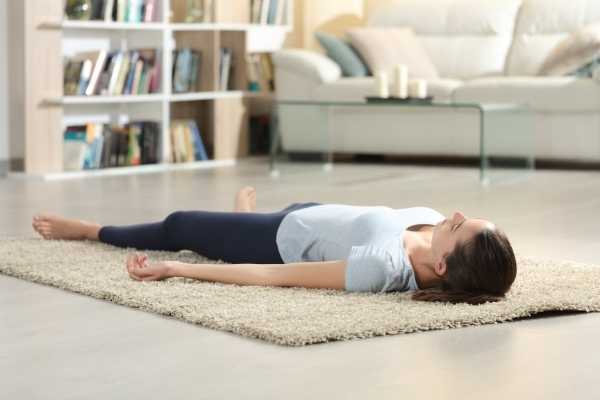
Early in my burnout I used body scans when I couldn’t sleep. I would slowly move up my body focusing on each body part. There were times I literally got distracted at my ankles. Getting up to my hips was an accomplishment.
So I was able to use the body scan in this way to actually measure my ability to focus. Which was poor.
But body scans do more than that. They help you get grounded in your body. Becoming more aware of your body sensations, improving interoception which a goal of being able sense your body how you are doing. Which…. helps you avoid burnout.

Yeah, wish I’d been doing body scans earlier.
Why I Still Meditate Lying Down (Sometimes)
At this point (more than a year into my meditating practice) I mostly meditate in a sitting pose.
This pose is generally preferred as it helps you keep your spine straight and makes it easier to stay alert.
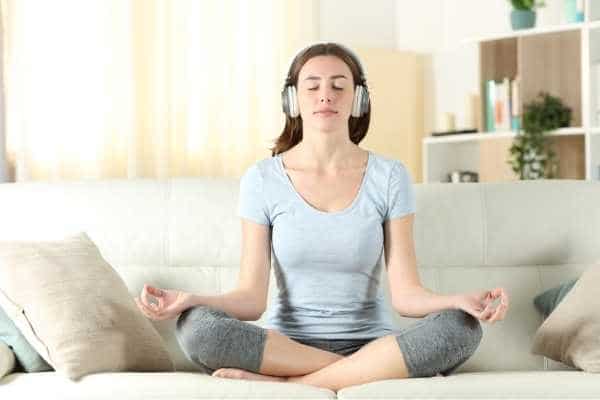
It is felt that the sitting pose gives you the proper balance of focus and relaxation, and it lets energy raise up to the brain.
I don’t really grasp those details, but it does seem easier to focus and meditate while sitting vs lying down. And yes, even making sure my spine is straight seems to help.
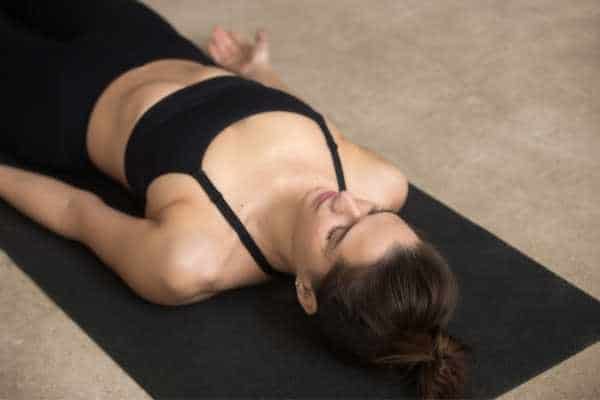
Reasons for Meditating Lying Down
But you don’t always want to be alert, you may need to relax the body. And this is a major reason to meditate lying down.
There are actually a ton of reasons someone might meditate lying down.
Maybe you are far along in your pregnancy and sitting is uncomfortable.

Maybe you are older and have some hip issues. Or you recently had a surgery. Or you have a health condition that means you are more comfortable lying down.
Maybe lying down is really the only meditation position that is an option for you.
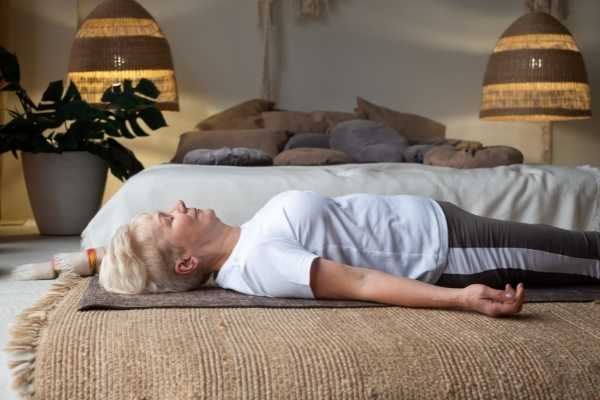
So if you need to mediate lying down, just for one practice, or all the time – go for it.
Simple Vagal Exercise Lying Down
A friend recommended I try Stanley Rosenberg’s simple vagal exercises from his book Accessing the Healing Power of the Vagus Nerve.
These simple exercises are designed to stimulate the vagus nerve. I tried it with a great deal of skepticism and was seriously surprised when it reduced my neck and face tension very quickly.
The basic exercise is done by lying down on your back. Take your hands and interlace your fingers and place them behind your head. You want to rest your head in your hands with your finger on your skull and your thumbs just at the base of your skull.
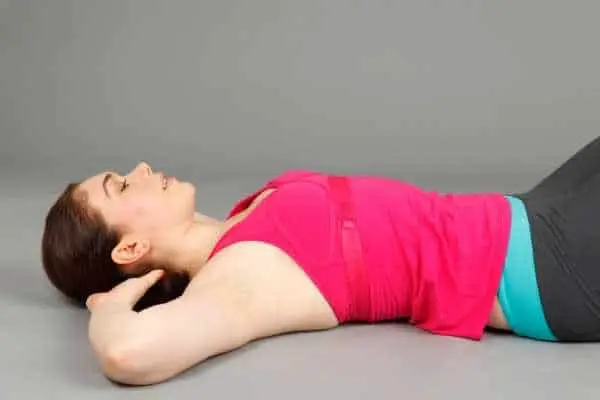
Now rotate your head and assess how easily and far you can turn to each side. Check for pain and tension.
Now for the exercise. Rest your head in the middle of your hands. Keep your head facing up, and without moving your head, look all the way to right with open eyes. Keep looking to the right for several seconds, 30 seconds or more. You should at some point feel a relaxation with a swallow, a sigh or a yawn. It may subtle or not.

Then move your eyes back to center, and now do it again on the left side.
And that is it. You can check your neck rotation again. I find mine is always better. At least for a little while.
It sounds crazy, but it turns out that our eyes convey a lot of information to our brain and looking sideways signals relaxation in some way.
Summary: Meditating Lying Down
The fact that I meditate is actually kind of amazing.
If you’d told me a couple of years ago that I would not only be meditating almost daily, but that I would think it was really important for my mental health and ability to focus…. well, I think I would have laughed at you.
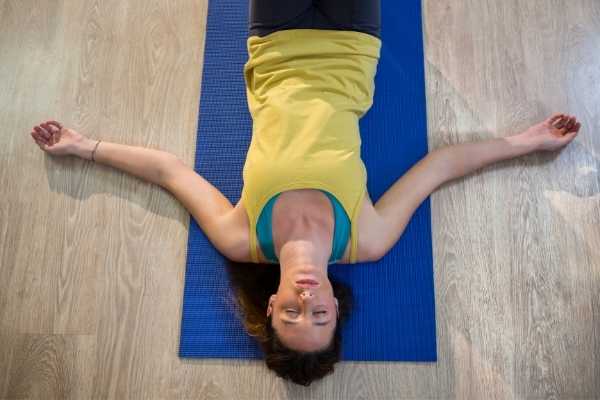
There is no way I could have started my meditation practice if I didn’t meditate lying down. So it can be a great way to start a meditation habit.
And Yoga Nidra is a form of meditation done lying down which is scientifically proven to reduce stress, help you relax and fall asleep more easily.
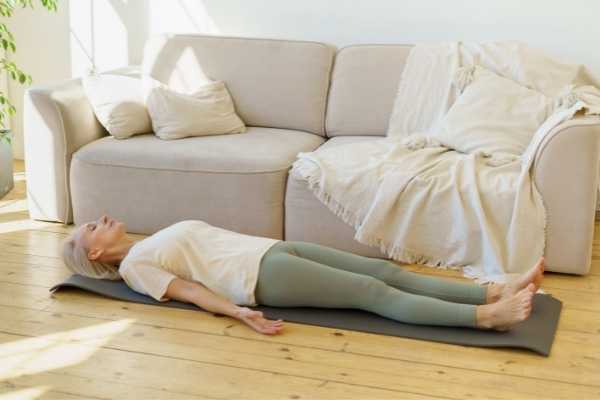
Meditation is a big part of my learning to feel and care for my body. I’m hoping to continue my meditation practice for many years.
Funny how things change, isn’t it?